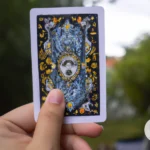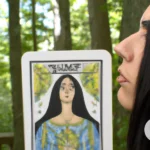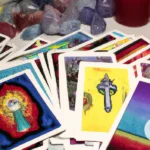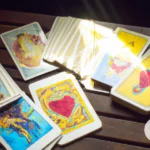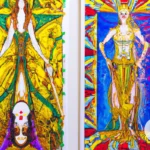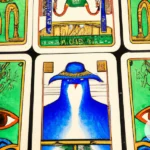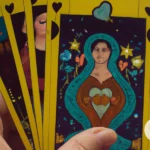As human beings, we are drawn to the mysterious and the extraordinary. Since time immemorial, we have been fascinated by mythical creatures that have been woven into our legends and lore. They ignite our curiosity and inspire us to think beyond the realm of the mundane. That is why the Mythic Tarot Deck has gained popularity among tarot enthusiasts. This deck is a treasure trove of mythical creatures that are both striking and enigmatic. The cards are replete with powerful symbols and compelling imagery that can help us connect with our subconscious mind. In this article, we will delve into the world of mythical creatures found in the Mythic Tarot Deck, explore their meanings and how they can enhance the power of tarot readings.
The Mythic Tarot Deck
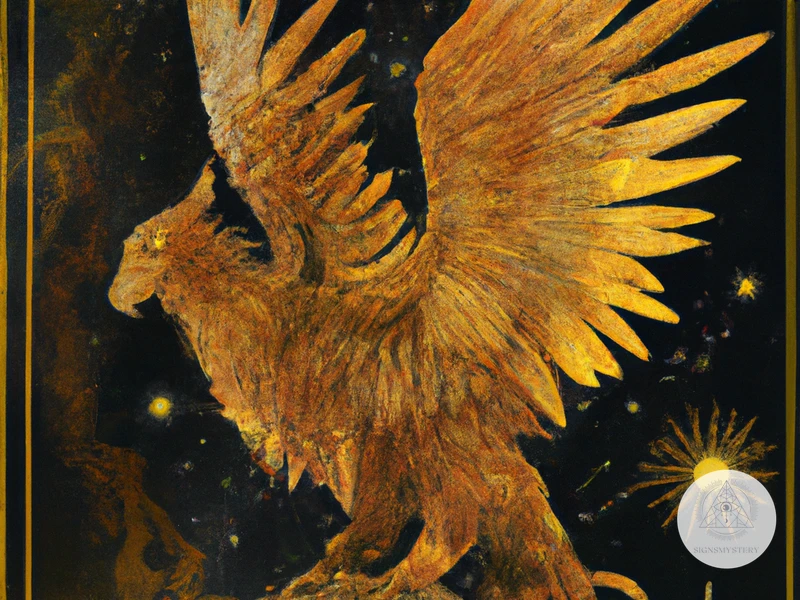
When it comes to tarot, there are many different decks to choose from. Each deck has its own unique style, symbolism, and mythology. However, if you’re looking for a deck that draws upon the rich myths and legends of ancient Greece, the Mythic Tarot deck might just be the one for you. In this section, we’ll delve deeper into the origin and composition of this deck, as well as take a closer look at some of the mythical creatures featured within it. If you’re curious about other popular tarot decks, be sure to check out our article on 10 Tarot Decks to Know, including the Rider Waite Tarot, the Thoth Tarot, and many more.
The Deck’s Origins
The origins of the Mythic Tarot Deck stem from the collaboration of two women, Juliet Sharman-Burke and Liz Greene. Juliet Sharman-Burke had been studying the tarot for many years, and Liz Greene was an expert in mythology, astrology, and psychology. They wanted to create a tarot deck that would combine the power of the tarot with the rich symbolism of Greek mythology. The idea of the Mythic Tarot was born.
Together, Sharman-Burke and Greene worked on the cards and the accompanying guidebook. The artwork for the cards was created by artist Tricia Newell. The result was a beautiful deck of cards that illustrated the myths and legends of ancient Greece.
The Mythic Tarot Deck was first published in 1986 by Simon & Schuster. It has since been reprinted and is still widely used by tarot readers today.
Compared to other tarot decks like the Rider-Waite Tarot Deck, the Thoth Tarot Deck, the Marseille Tarot Deck, the Illuminati Tarot Deck, the Shadowscapes Tarot Deck, the Wild Unknown Tarot Deck, the Nature Druid Tarot Deck, and the Faeries Oracle Deck, the Mythic Tarot Deck stands out because of its unique blend of tarot and Greek mythology.
Introducing the Cards
In the Mythic Tarot Deck, each card features a stunning illustration of a character or scene from Greek mythology, accompanied by a brief description and interpretation. The deck consists of 78 cards, divided into the 22 Major Arcana cards and 56 Minor Arcana cards, which are further divided into four suits: Cups, Wands, Swords, and Pentacles.
The Major Arcana cards are significant characters in Greek myth, such as The Fool is represented as Icarus, and The Magician as Hermes. The Minor Arcana cards, on the other hand, feature iconic creatures from Greek mythology, ranging from centaurs to phoenixes.
Each suit corresponds to a different element and aspect of life. Cups represent emotions and water, Wands represent action and fire, Swords represent thoughts and air, while Pentacles represent material possessions and earth.
The cards in the Minor Arcana suits are numbered one through ten, with each number representing a different facet or intensity of the card’s meaning. Each suit also has four court cards: the Page, Knight, Queen, and King. These cards correspond to specific individuals in Greek mythology, and the illustrations on the cards depict them in various scenarios.
The Mythic Tarot Deck is a great addition to any tarot enthusiast’s collection, as it offers a unique look at Greek mythology through its stunning illustrations and interpretations. It is comparable to other popular tarot decks such as the Rider-Waite Tarot Deck, the Thoth Tarot Deck, the Marseille Tarot Deck, the Illuminati Tarot Deck, the Shadowscapes Tarot Deck, the Wild Unknown Tarot Deck, the Nature Druid Tarot Deck, and the Faeries Oracle Deck.
Exploring Mythical Creatures in the Deck
As we dive deeper into the Mythic Tarot Deck, we cannot help but be captivated by the mythical creatures that adorn its cards. Each creature, with its unique characteristics and symbolism, adds layers of depth and intrigue to the tarot reading experience. From the fierce Minotaur to the magical Phoenix, the deck is replete with fantastical animals that have captured our collective imagination for centuries. Let’s take a closer look at some of these captivating creatures and unlock the secrets they hold.
The Minotaur
One of the most fascinating mythical creatures in the Mythic Tarot deck is the Minotaur, a creature that is half-man and half-bull. This powerful creature has captured the imagination of people for centuries and is often depicted as a fearsome beast ready to do battle with anyone who crosses its path. So, what does this creature represent in the Tarot?
Symbolism and Meanings of the Minotaur in Tarot
The Minotaur is a symbol of our primal nature and the animalistic side of ourselves that we often try to suppress. In the Tarot, the Minotaur is often depicted in the card “The Devil,” which represents temptation, materialism, and addiction. The Minotaur reminds us that we must confront our darker side if we hope to move forward and achieve true balance in our lives.
Interpreting the Minotaur in a Tarot Reading
When the Minotaur appears in a tarot reading, it usually signals a need to face your fears and confront your shadow self. The card may suggest that you are indulging in unhealthy or addictive behaviors that are holding you back from reaching your full potential. Alternatively, the Minotaur may represent a powerful force in your life that you must confront and overcome before you can move forward.
Here is a table summarizing the key aspects of the Minotaur in Tarot:
| Aspect | Meaning |
|---|---|
| Symbolism | Primal nature, animalistic side of ourselves |
| Tarot Card | The Devil |
| Interpretation | Confronting fears and shadow self, overcoming powerful forces |
The Minotaur is just one of the many fascinating creatures in the Mythic Tarot deck, each with their own unique symbolism and meaning. As you explore the Tarot and the powerful creatures within it, you will gain a deeper understanding of yourself and your place in the world.
The Griffin
One of the most fascinating creatures in the Mythic Tarot Deck is the Griffin. This mythical creature is a combination of an eagle and a lion, representing the union of the king of beasts and the king of birds. The Griffin is often depicted as having the head of an eagle, the body of a lion, and wings of an eagle.
In Greek mythology, the Griffin was said to be a fierce protector of treasure, and it was often depicted as guarding gold mines. The Griffin represents strength, courage, and vigilance, and is said to be a symbol of divine power. It is revered in many cultures as a guardian of the divine, a wise and noble creature, and a protector of the innocent.
In tarot, the Griffin is often used to represent a need for protection, strength, or courage in the face of adversity. It can also represent a search for inner wisdom and spiritual guidance. When the Griffin appears in a tarot reading, it may be a sign that the querent needs to be strong, brave, and steadfast in the face of challenges, and to be vigilant in protecting what is important.
Some of the key meanings associated with the Griffin in tarot include:
- Strength: The Griffin is a symbol of strength and courage, representing the ability to overcome obstacles and challenges through perseverance and determination.
- Protection: The Griffin is known as a fierce protector of treasure, and in tarot it can represent the need for protection and security. It can also symbolize a need to be vigilant and watchful, and to take steps to guard against harm.
- Wisdom: The Griffin is often seen as a wise and noble creature, and in tarot it can represent the search for inner knowledge and guidance. The Griffin may appear in a reading as a sign that the querent needs to seek out spiritual wisdom or divine guidance.
- Divine Power: The Griffin is revered in many cultures as a symbol of divine power, and in tarot it can represent the presence of a higher power or spiritual force at work in the querent’s life. It may be a sign of spiritual protection or a call to connect with a higher purpose or spiritual path.
The Griffin is a powerful and inspiring creature that can offer guidance and support in times of need. Whether representing strength, protection, wisdom, or divine power, the Griffin is a symbol of fortitude and resilience that can help the querent face any challenge with courage and grace.
The Phoenix
One of the most well-known mythological creatures in the world is the Phoenix. In the Mythic Tarot Deck, the Phoenix appears as the card of Judgement. The Phoenix is a symbol of rebirth, renewal, and regeneration.
| Attribute | Description |
| — | — |
| Appearance | The Phoenix is depicted as a large, fiery bird with a long tail and wings. It is typically shown in shades of red, orange, yellow, and gold. |
| Symbolism | The Phoenix represents transformation, letting go of the old to make way for the new, and rising from the ashes. It is a reminder that sometimes life has to be destroyed to create something new and better. |
| Meaning in Tarot | In the Tarot, the Phoenix card is a reminder to shed the old self and embrace transformation. It is also a call to examine one’s actions and the consequences that come with them. The Phoenix is a card of redemption and forgiveness. |
| How to Interpret in Readings | When the Phoenix appears in a reading, it is a sign that a major change or transformation is coming. It may indicate the need to let go of past hurts or mistakes in order to move forward. It can also signify a period of healing or regeneration. The Phoenix encourages taking responsibility for one’s actions and seeking forgiveness if necessary. |
The Phoenix is a powerful symbol of transformation and rebirth. Its fiery energy can help us to release the past and embrace new opportunities. When interpreting the Phoenix card in a tarot reading, it is important to approach it with an open mind and a willingness to embrace change.
The Sphinx
The Sphinx in the Mythic Tarot Deck is a powerful and enigmatic creature that symbolizes mystery, riddles, and puzzles. In Egyptian mythology, the Sphinx was often depicted as a lion with the head of a human, usually that of a pharaoh. This blending of human and animal characteristics serves to emphasize the Sphinx’s ambiguity and to make it a truly unique creature.
In the Mythic Tarot Deck, the Sphinx is depicted as a mysterious and powerful creature that guards the path to spiritual enlightenment. The card shows a female Sphinx with the body of a lion and the head of a woman. She sits on a stone throne with her arms crossed, looking directly at the viewer with a fierce and challenging gaze.
One of the key features of the Sphinx is its riddle. In mythology, the Sphinx would often ask travelers a riddle, and only those who could solve it would be allowed to pass. The riddle itself is often seen as a symbol of the unknown or the hidden, and the Sphinx represents the challenge of uncovering the truth.
In the Mythic Tarot Deck, the Sphinx represents the challenge of uncovering the hidden truths within ourselves. Her fierce and unyielding gaze serves to remind us that these truths can be difficult and uncomfortable to face, but that they are ultimately necessary for growth and personal transformation.
Incorporating the Sphinx into your tarot readings can be a powerful tool for self-discovery and spiritual growth. The Sphinx’s challenge encourages us to take a deeper look at ourselves and our motivations, and to confront the parts of ourselves that we may be afraid to acknowledge. By embracing the mystery and challenge of the Sphinx, we can unlock new insights and discover a deeper understanding of ourselves and the world around us.
The Sphinx in the Mythic Tarot Deck is a powerful and thought-provoking creature that challenges us to look within ourselves and uncover the hidden truths of our own psyche. Its symbolism and meaning can provide valuable insights for anyone seeking to explore the mysteries of tarot and the self.
The Mermaid
One of the
Subscribe to Our Newsletter
Sign up to receive the latest news and updates.
Appearance
The Mermaid in the mythic tarot deck is depicted as a beautiful woman with long hair and a fish tail. Her tail is usually adorned with scales and fins, and her upper body is bare. The Mermaid is often shown floating underwater or perched on a rock by the ocean.
Meaning
The Mermaid is a symbol of sensuality, mystery, and hidden depths. As a creature of the water, she is associated with emotions, intuition, and the unconscious mind. In a tarot reading, the Mermaid may indicate a need to dive deep into one’s emotions and explore the unknown.
Mythology
Mermaids have been present in myths and folklore across cultures since ancient times. In Greek mythology, they were the daughters of the sea god Triton and the nymph Amphitrite. In Norse mythology, they were known as the “merrow” and were believed to reside in the depths of the ocean. In many cultures, mermaids were seen as both enchanting and dangerous, luring sailors to their death with their songs and beauty.
Incorporation into Tarot Readings
When the Mermaid appears in a tarot reading, it may be a sign to pay attention to one’s emotions and intuition. The Mermaid may be urging the querent to delve deeper into their unconscious mind to uncover hidden truths. She may also indicate the need to explore one’s sensuality and embrace their feminine power.
Using imagery of the Mermaid in tarot spreads can also enhance the reading’s depth and symbolism. For example, placing a card with the image of a Mermaid in the “past” position may indicate the querent is still processing an emotional experience from their past.
Conclusion
The Mermaid is a beloved symbol of mysterious depths and alluring sensuality. Her appearance in the mythic tarot deck adds an element of water to the deck’s symbolism, reminding us of the importance of emotions and intuition in our lives. Whether used in a reading or simply admired for her beauty, the Mermaid is a fascinating and powerful archetype in tarot.
Symbolism and Meanings of Mythical Creatures in Tarot
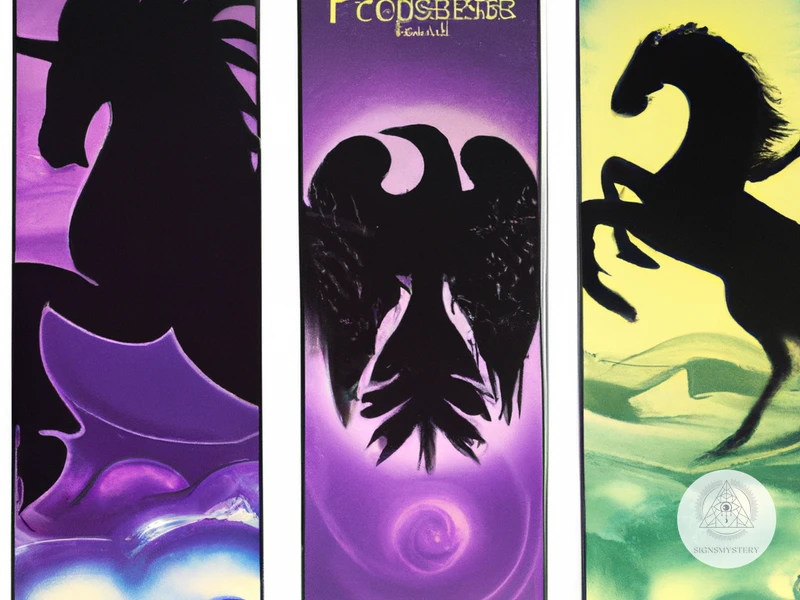
Mythical creatures have been an integral part of human mythology since the beginning of time. In Tarot, these creatures are not just used for their visual appeal, but also carry symbolic meanings that add depth and complexity to a reading.
One such creature is the minotaur, which is often depicted as a man with the head of a bull. This creature can represent primal instincts, brute strength, and the struggle to control those instincts. The griffin, a creature with the body of a lion and the head of an eagle, can symbolize courage, vigilance, and the ability to see the bigger picture.
The phoenix, a mythical bird that rises from its own ashes, can represent rebirth, transformation, and new beginnings. The sphinx, a creature with the body of a lion and the head of a human, can symbolize mystery, riddles, and the search for truth. Finally, the mermaid, a creature that is half-human and half-fish, can represent a balance between the emotional and practical aspects of life.
In Tarot, these creatures can be used to add nuance to a reading. For example, the minotaur may be used to represent a difficult internal struggle or a need for self-control. The griffin may be used to highlight the need for bravery and taking a more holistic view of a situation. The phoenix may offer hope for a fresh start or a new perspective, while the sphinx can represent a need to unravel a mystery or seek the truth in a situation. Finally, the mermaid may serve as a reminder to balance emotions and practicality.
It is important to note that the meanings of these creatures may vary depending on the deck being used or the contextual position of the card in a spread. However, their symbolic meanings are rich, deep, and can be incorporated into readings with skill and intuition.
Mythical creatures have a long history of being used in human mythology, and are imbued with complex symbolism and meaning that can be applied to Tarot readings. Each creature can represent a different aspect of human experience or offer insight into a particular situation. It is up to the Tarot reader to harness that symbolism with care and creativity, to provide a reading that is both nuanced and insightful.
How to Incorporate Mythical Creatures in Tarot Readings
Incorporating mythical creatures in tarot readings can add a layer of depth and complexity to your practice. These creatures often have symbolic meanings and can help you delve deeper into the meaning of the cards. Here are some ways to incorporate mythical creatures in your tarot readings:
Choose a creature card as a significator: A significator is a card that represents the querent (the person receiving the reading). Instead of using a traditional court card or a card based on physical characteristics, you can choose a creature card that resonates with the querent. For example, if the querent is going through a transformative period in their life, you could choose the Phoenix card to represent them.
Use creature cards to clarify the meaning of other cards: Sometimes, a card in a reading can be confusing or unclear. In these cases, you can draw a creature card to help clarify the meaning. For example, if the Death card appears in a reading, you could also draw the Sphinx card to add another layer of insight into the transformative process the Death card represents.
Draw a creature card to represent a situation: If you’re doing a reading about a specific situation, you can draw a creature card to represent the situation. For example, if you’re doing a reading about a difficult decision someone is facing, you could draw the Griffin card to symbolize the need to balance intellect and emotion when making the decision.
Use creature cards to create a narrative: In a multi-card reading, you can use creature cards to create a more complex narrative. For example, if you’re doing a three-card spread about a relationship, you could use the Minotaur card to represent the initial challenge in the relationship, the Mermaid card to represent the emotions involved, and the Phoenix card to represent the potential for transformation and growth.
Remember, the symbolism and meanings of mythical creatures in tarot are not set in stone. It’s important to use your intuition and personal interpretation to fully understand the connections between the creatures and the cards in your readings. With practice and experimentation, incorporating mythical creatures in your tarot practice can help deepen your understanding of the cards and the human experience they represent.
Conclusion
In conclusion, the Mythic Tarot Deck offers a unique and intriguing exploration of mythical creatures in the realm of tarot. Delving into the symbolic meanings and interpretations of creatures such as the Minotaur, Griffin, Phoenix, Sphinx and Mermaid can add depth and nuance to tarot readings. These creatures serve as archetypes that can help us connect to the collective unconscious and offer valuable insights into our own personal journeys.
One of the strengths of the Mythic Tarot Deck is its integration of Greek mythology and tarot symbolism, creating a singular world within the cards. This allows for a richer, more nuanced interpretation of readings, and encourages the reader to engage with the cards in a more meaningful way.
By understanding the symbolism and meanings of mythical creatures in tarot, readers can incorporate them into their practice in a variety of ways. Whether it’s adding a creature card to a spread, meditating on a particular creature, or simply contemplating the qualities that creature embodies, working with these archetypes can deepen one’s connection to the tarot and the larger forces at work in the universe.
Overall, the exploration of mythical creatures in tarot is an endlessly fascinating and rewarding endeavor. The Mythic Tarot Deck offers a unique perspective on these creatures and their symbolic significance, making it a valuable addition to any tarot collection. With its evocative imagery and rich symbolism, the deck invites us to delve deeper into the mysteries of the universe and gain a greater understanding of ourselves in the process.
Frequently Asked Questions
What is the Mythic Tarot Deck?
The Mythic Tarot Deck is a tarot deck inspired by Greek mythology and features mythical creatures, heroes, and gods.
Where did the Mythic Tarot Deck come from?
The Mythic Tarot Deck was created by Juliet Sharman-Burke and Liz Greene in the 1980s.
What are the origins of the deck?
The deck is based on the Rider-Waite tarot deck but with a twist, as it incorporates myths from Greek mythology
What is the significance of the Minotaur card?
The Minotaur represents chaos, confusion, and repressed anger, and it can suggest a need to face and confront one’s inner demons.
What does the Griffin card symbolize?
The Griffin represents strength, courage, and determination, and it can suggest an increase in personal power.
What is the meaning behind the Phoenix card?
The Phoenix represents transformation, rising from the ashes, and rebirth, and it can suggest a change or renewal in one’s life.
What does the Sphinx card signify?
The Sphinx represents mystery, riddles, and secrets, and it can suggest the need to use one’s intuition and intellect to solve a problem or answer a question.
What is the symbolism of the Mermaid card?
The Mermaid represents emotions, intuition, and creativity, and it can suggest the need to trust one’s feelings and go with the flow.
How can mythical creatures be incorporated into Tarot readings?
Mythical creatures can be used to add depth and richness to a tarot reading, as they can bring in different energies and archetypes.
What is the significance of using Greek mythology in tarot readings?
Greek mythology is full of rich stories and archetypes that can provide a greater understanding of oneself and the world, and can help individuals connect with universal themes and energies.



